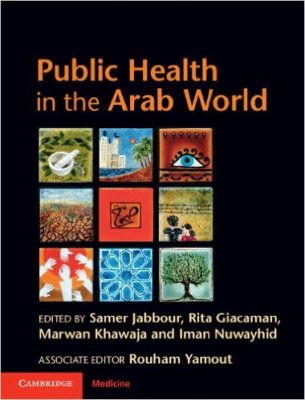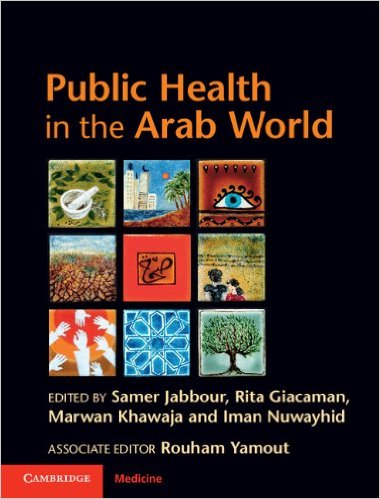 Editors: Samer Jabbour, Rita Giacaman, Marwan Khawaja, and Iman Nuwayhid
Editors: Samer Jabbour, Rita Giacaman, Marwan Khawaja, and Iman Nuwayhid
Associate Editor: Rouham Yamout
Publisher: Cambridge University Press – 502 pages
Book Review by: Sonu Chandiram
This book was published in 2012, while the so-called Arab Spring was going on, which occurred between December 2010 and mid-2012. This was a wave of violent and non-violent demonstrations and riots in several Middle East countries: Algeria, Bahrain, Egypt, Iraq, Jordan, Kuwait, Morocco, Oman, Saudi Arabia, Syria, Tunisia, and Yemen.
This book has been put together for the benefit of academics, researchers, and students of public health, as well as medicine, other health professions, and Arab/Middle East studies. Public health practitioners, health policy makers, health program managers, and people working in or with regional and international organizations involved in population, health, development and/or humanitarian aid will also find this book useful.
As far as the Middle East is concerned, “public health in the region has not received the attention it deserves,” write the five editors named above in their Introduction. This book addresses that lack of attention, including political and social issues affecting health.
What constitutes the Middle East when speaking about health? One way to answer that question is to refer to health organizations. The Eastern Mediterranean Regional Office of the World Health Organization serves these 22 countries: Afghanistan, Bahrain, Djibouti, Egypt, Iran, Iraq, Jordan, Kuwait, Lebanon, Libya, Morocco, Occupied Palestinian Territory, Oman, Pakistan, Qatar, Saudi Arabia, Somalia, Sudan, Syria, Tunisia, United Arab Emirates, and Yemen. (Other countries in the Middle East are: Algeria, Comoros, Israel, Mauritania, and Turkey).
Eighty-six people contributed to this volume. They’re from around the world, although most of them are from the Middle East, particularly Lebanon. Here is an alphabetical list of the 20 countries represented: Australia, Bahrain, Belgium, Canada, Egypt, France, Jordan, Kuwait, Lebanon, Morocco, Occupied Palestinian Territory, Qatar, Saudi Arabia, Sudan, Switzerland, Syria, Tunisia, United Arab Emirates, the United Kingdom, and the United States.
There are 38 chapters in this book organized around these seven Sections:
- Section 1. The Context of Public Health
- Section 2. The Social Determinants of Health
- Section 3. Health and Disease: A Focus on Avoidable Conditions
- Section 4. The Health of Population Groups
- Section 5. Public Health in War and Violent Conflict
- Section 6. Health Systems: Toward Equity and Accountability
- Section 7. Public Health and the Social Agenda
In the Introduction, the editors note: “There is agreement among the authors and editors of this book on the values that underpin this work. The starting point is seeing health as a right engraved in social contracts between the state and its citizens.”
“Social solidarity, engagement of the public, and mobilization of community capacity are considered the most important mechanisms to promote health. Health promotion is seen within the context of work toward equity, social justice, and broader social change.”
The authors of the first chapter – Public Health, the Medical Profession, and State Building: A Historical Perspective take a look at the history of public health in the Middle East, the challenges it still faces today, and the options for future action. Some key themes emerge from their overview:
- Impact of colonialism and encounter with Western medicine
- Relation of public health with state building and modernization
- Role of the medical profession
- Changing policies in relation to changing political and economic realities
Each of the 38 chapters of this book begin with an introductory paragraph or two, the Approach taken in examining the issues relating to the chapter title, discussions of topics and subtopics, Conclusions in several paragraphs, and a list of References for further study. Tables containing data are provided, but no other illustrative features are used.
The state of health from one country to another in the Middle East varies greatly depending on economics and politics in each one. In terms of economics, the region is home to some of the wealthiest nations with high per capita incomes to some of the poorest as well. The presence or absence of political stability is another determinant factor in the overall health of the population.
In their Postscript, the editors write: “the people of the region are hoping for democratization, good governance and accountability, a brighter future, new opportunities, and life with dignity.” They relate political stability to health, quoting the authors of chapter 18 (Rima Afifi, et al): “the health of young people cannot be fully realized without attention to ensuring dignity and the attainment of all human rights.”
Editors:
Samer Jabbour is Senior Lecturer in the Faculty of Health Sciences at the American University of Beirut, Lebanon.
Rita Giacaman is a Professor of Public Health at the Institute of Community and Public Health, Birzeit University, West Bank, Occupied Palestinian Territory.
Marwan Khawaja is Chief of the Social Statistics Section at UN Economic and Social Commission for Western Asia (UN ESCWA) in Beirut, Lebanon.
Iman Nuwayhid is Professor and Dean of the Faculty of Health Sciences at the American University of Beirut, Lebanon.
Associate Editor:
Rouham Yamout is Research Associate in the Faculty of Health Sciences at the American University of Beirut, Lebanon.
Foreword:
Richard Horton, FRCP, FMedSci at The Lancet, 32 Jamestown Road in London, United Kingdom. Email: richard.horton@lancet.com







